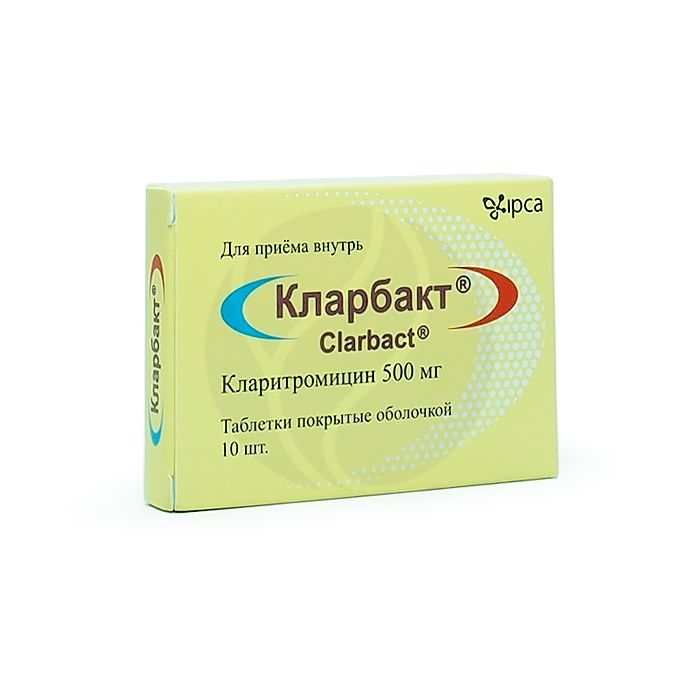Clarbact tablets 500mg, No. 10
Expiration Date: 05/2027
Russian Pharmacy name:
Кларбакт таблетки 500мг, №10
lower respiratory tract infections (such as bronchitis, pneumonia);
upper respiratory tract infections (such as pharyngitis, sinusitis);
infections of the skin and soft tissues (such as folliculitis, inflammation of the subcutaneous tissue, erysipelas);
mycobacterial infections caused by Mycobacterium avium and Mycobacterium intracellulare. Localized infections caused by Mycobacterium chelonae, Mycobacterium fortuitum and Mycobacterium kansasii;
prevention of the spread of infection caused by the Mycobacterium avium complex (MAC). HIV-infected patients with a CD4 lymphocyte (T-helper lymphocyte) count of no more than 100 per 1 mm3;
to eliminate H. pylori and reduce the frequency of recurrence of duodenal ulcers;
odontogenic infections.
Inside, regardless of food intake.
Usually, adults are prescribed 250 mg of clarithromycin 2 times a day. In more severe cases, the dose is increased to 500 mg 2 times a day. Typically, the duration of treatment is 5-6 to 14 days.
Patients with Cl creatinine less than 30 ml / min are prescribed half of the usual dose of clarithromycin, i.e. 250 mg 1 time per day, or for more severe infections - 250 mg 2 times a day. Treatment of such patients continues for no more than 14 days.
For mycobacterial infections, 500 mg of the drug is prescribed 2 times a day.
For common infections caused by MAC in AIDS patients: Treatment should be continued as long as there is clinical and microbiological evidence of its benefit. Clarithromycin should be given in combination with other antimicrobial agents.
In case of infectious diseases caused by mycobacteria, except for tuberculosis: the duration of treatment is determined by the doctor.
For the prevention of infections caused by MAC. The recommended dose of clarithromycin for adults is 500 mg 2 times a day.
For odontogenic infections, the dose of clarithromycin is 250 mg 2 times a day for 5 days.
For the eradication of H. pylori
Combined treatment with three drugs
Clarithromycin 500 mg 2 times a day in combination with lansoprazole 30 mg 2 times a day and amoxicillin 1000 mg 2 times a day for 10 days.
Clarithromycin at a dose of 500 mg 2 times a day in combination with amoxicillin at a dose of 1000 mg 2 times a day and omeprazole at a dose of 20 mg / day for 7-10 days.
Combined treatment with two drugs
Clarithromycin at a dose of 500 mg 3 times a day in combination with omeprazole at a dose of 40 mg / day for 14 days, with the appointment of omeprazole at a dose of 20Ц40 mg / day for the next 14 days.
Clarithromycin 500 mg 3 times a day in combination with lansoprazole 60 mg / day for 14 days. For complete healing of the ulcer, an additional decrease in gastric acidity may be required.
| Film-coated tablets | 1 tab. |
| active substance: | |
| clarithromycin | 250 mg |
| 0.5 g | |
| Excipients | |
| tablet core 250 mg: croscarmellose sodium; MCC; pregelatinized starch; silicon dioxide; povidone; stearic acid; magnesium stearate; talc; quinoline yellow E104 | |
| 250 mg tablet shell: hypromellose; hyprolosis; propylene glycol; sorbitan monooleate; titanium dioxide; sorbic acid; vanillin; quinoline yellow (E104) | |
| tablet core 0.5 g: croscarmellose; MCC; silicon dioxide; povidone; stearic acid; magnesium stearate; talc | |
| tablet shell 0.5 g: hypromellose; hydroxypropyl cellulose; propylene glycol; sorbitan monooleate; titanium dioxide; sorbic acid; vanillin; quinoline yellow (E104) |
hypersensitivity to drugs of the macrolide group;
simultaneous administration of clarithromycin with the following drugs: astemizole, cisapride, pimozide, terfenadine, ergotamine, dihydroergotamine (see Interaction);
porphyria;
pregnancy;
lactation period;
children under 3 years of age (see 'Special instructions').
With care: impaired liver and kidney function.
Clarithromycin is excreted primarily by the liver. In this regard, caution should be exercised when prescribing an antibiotic to patients with impaired liver function. Caution should be observed when treating clarithromycin in patients with moderate to severe renal impairment. In clinical practice, cases of toxicity of colchicine when combined with clarithromycin have been described, especially in the elderly. Some of them were observed in patients with renal insufficiency; several deaths have been reported in these patients (see Interaction Ч Colchicine). Consideration should be given to the possibility of cross-resistance between clarithromycin and other macrolide drugs, as well as lincomycin and clindamycin.

